|
Polar
Research Today:
The
Tragedy of
America's
Exploited Black Pioneer
Polar Explorer
Matthew
Henson
| |
|
.. |
|
|
| |
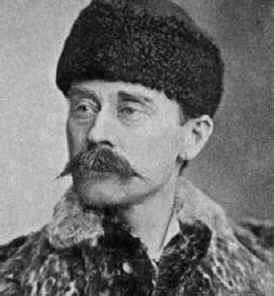 |
|
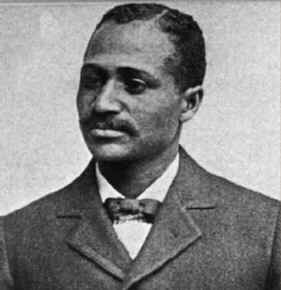 |
|
| |
|
.. |
|
|
|
.. |
Robert
E. Peary: his
'manservant' was
a dupe of his giant
ego and ambition |
.. |
Matthew
A. Henson:
he saved Peary's
life
and reputation, to
be
denied and refected |
.. |
|
.. |
|
. |
|
.. |
1
The tragedy of Matthew
Henson America's exploited
Black Polar Explorer
For
nearly 20 years in the
Arctic, Matthew Henson
endured as Peary's
"manservant,"
later to be discarded by
the man who took all the
"glory and
honor." His later
life was of belated
recognition, then a sad
revisionist exploitation
after his death.
by
Russell W. Gibbons
Professional
and amateur historians who
seek to revise history to
fit a political or cultural
agenda often fall into the
trap of selective analysis
ignoring the obvious and
making unwarranted
conclusions based upon an
ideological agenda rather
than honest conclusions.
The
story of Matthew Henson
(18671955) suggests this
approach to selective
biographical history.
Henson was an exceptional
participant on the
landscape of American
Arctic exploration in the
last decade of the 19th
century and the first of
the 20th. His was the
classic case of an American
Black with abilities not
afforded any opportunity in
the reconstruction period,
and subject to the racism
still in place in
"official"
circles as well as in
society.
That
he achieved status was
largely despite the
"manservant"
relationship with his
employer of 23 years,
Robert Edwin Peary. It may
be too simple to categorize
Peary as a racist; suffice
to say that he reflected
the class attitudes of his
background and the family
into which he married. To
them Blacks were but a
structured servile
component of society, an
arrangement not to be
questioned and not to be
challenged.
Henson
has his advocates, as well
he should, for he was the
pioneer black Polar
explorer. His place in
history was earned, but the
commentary in another part
of this examination of the
Henson-Peary-Cook
relationship points out the
difficulty of historic
revisionism based solely on
cultural and racial
criteria. Robert Peary, in
some of this literature is
portrayed as a
"lifelong friend and
colleague" of Henson,
which is anything but the
truth.
Peary
used Henson and considered
him "an extension of
the will in my five
fingers." Allen
Counter achieved the
reinterment of Henson and
his wife in the shadow of
Peary's massive globe
monument at Arlington
National Cemetery, but was
totally naive in ignoring
the fact that in life Peary
used, excluded and finally
rejected his black
companion. Consider this
letter from Peary to his
backer Herbert Bridgeman in
stressing that Henson's
expedition bonus was not a
"bribe" (Peary
Family Papers, Oct. 19,
1910):
"If
he has any idea whatever
that his check was anything
especial I hope you will
disabuse him of that idea
completely and permanently.
I would not have him get
the idea that I am
endeavoring to do anything
for him or that I am trying
to get solid or any allied
idea for a thousand
dollars. He has
deliberately and
premeditatedly deceived me
and I am done with him
absolutely."
The
fiction that the two Arctic
travelers considered each
other equal in their role
and judgment is expressed
in the words of both.
Peary's rage knew no bounds
following Henson's abortive
lecture series, in which he
suggested that "the
old man" had been but
sledge baggage, with Henson
breaking the trail and, in
effect, becoming the first
to arrive at what would
later be claimed as the
North Pole. Henson told the
Boston American
(July 17, 1910) that:
"After
twenty-two years of service
with Peary we are now as
strangers. Three times in
his company I crossed the
"Great Lead"
north of Cape Columbia on
my way towards the Pole,
and three times we
recrossed together. The
last round trip was the
successful one. The North
Pole was reached. Three
hearty American cheers were
given for Old Glory as we
waved from an icy pinnacle.
It was the culmination of a
struggle lasting all those
years, in which Commander
Peary, the employer, and I,
plain Matt Henson, the
servant, had worked and
starved and frozen
together. From the moment I
declared to Commander Peary
that I believed we stood
upon the Pole he apparently
ceased to be my
friend."
This
was a sad public
acknowledgment that Peary
affirmed that Henson was
anything other than the
"servant" which
he (Henson) accepted, and
that the man who would
later boast that he
"was the only white
man" to be at the Pole
considered Henson as but
another of his Inuit
"helpers." He
accepted his role to his
"employer," and
in the decade following
their return and break, his
employer of 23 years did
nothing of record to
improve Henson's
circumstances, despite the
considerable political
influence which he
commanded through his Peary
Arctic Club sponsors and
the family of his wife,
Josephine.
Henson
and Peary were inextricably
linked in field success and
later in the inevitable
failures of the 1906 and
1909 expeditions. Henson
was dependent upon Peary
for virtually all of the
working years of his life
and the damning sequel of
Peary's deliberate
abandonment of his
"dark companion"
is something which the
Henson revisionists refuse
to accept. Peary could not
have survived without
Henson in the last decade
of his work, yet in the
end, he rejected him. Jo
Peary called him a
"vainglorious
braggart" and with the
other inner circle bitterly
resented his abortive
lecture tours and the
publication of his book, A
Negro Explorer at the North
Pole. (Even
after his rejection of
Henson, Peary did write a
forward in which he
recalled his message to the
1909 testimonial that
"I congratulate you
and your race.")
Peary's daughter Marie, as
late as 1962, wrote a
Henson biographer that
"there was nothing
remarkable about
Henson."
Jean
Malaurie, the French
explorer who spent years
living with the Polar
Eskimos, and is considered
the foremost anthropologist
of the Inuit, wrote of the
Henson and Peary Arctic
progeny in The Last
Kings of the Thule,
long before they were
acknowledged by their
American families.
Only
a minority of Arctic
explorers took Inuit
mistresses but Henson and
Peary were in that small
group. Malaurie wrote of
Kali Peary, who told
Malaurie that, "I
never heard a word from my
illustrious father."
Annaakkaq Henson had a
tormented conversation with
Malaurie in the 1960's:
"Have
you seen him? Is he happy?
If he isn't rich then let
him come here and I will
take care of him in his old
age" Anaakkaq related
that the tribe knew that
"Piulissuaq" (Peary)
not only disavowed his
Inuit son, but that he had
provided "hardly any
financial help" to
Henson in America.
Henson's
contract was bought up by
the lecture management; his
book a publishing nonevent.
He faced the ultimate
rejection from "the
old man," who saw both
events as disloyalty.
"After my looking
after him for years,"
Peary lamented to Bridgeman,
"he has now, for the
sake of a few dollars,
deliberately and
intentionally broken faith
with me." Henson
expresses his feelings of
this rejection in the
interview with the Boston
American (see
Part IV). His reward would
be a messenger's job in the
Federal Court House secured
not by Peary but a black
politician. It paid $900 a
year.
In
their fury over denial, the
Henson revisionists on the
Internet have unleashed an
appalling attack on
Frederick A. Cook, to whom
they attribute the initial
suspicion and ultimate
doubt over Peary's claims
which in time became the
Henson-Peary claims. It is
not just disagreement with
the Cook position it is
pure vitriol of an
unrestrained nature, an
abhorrent assault that
would turn off any serious
scholar of the topic. This
commentary on the author of
the Henson website may say
it best:
"The
person who writes the
material for the [Henson]
website is by all counts a
troubled man, very insecure
about himself and his cause
and with an apparent
irresolute conviction that
[Cook] was the cause of the
downfall of his two
historical heroes. The use
of slander and vulgar
epithets removes any
serious consideration for
his arguments [this is] one
of the worst examples of
misuse of the freedom of
the Internet that I have
encountered, and is
especially distressing
because it alleges to be a
part of black history and
in truth is an
embarrassment to that
history. I found 'askoj.com'
while surfing through
it"
This
special five part feature
on Henson in part addresses
the Internet slander, but
places in perspective the
"codiscoverer"
myth, the allegations that
Cook "was not an
explorer of note"
prior to the 190709
expedition, the
relationship of Henson to
the Inuit, Peary and Cook,
and the revealing 1910 Boston
American interview.
Matthew
Henson will survive in
Polar history as a man of
courage and talent, as well
as a victim of the racism
of his times. He deserves
better than revisionism.
His story deserves the same
truth that has emerged
about Robert E. Peary and
Frederick A. Cook in the
past century. That truth
will truly set Matthew
Alexander Henson free in
any honest history of his
times.
Matthew
Alexander Henson (1866 -
1955)
Henson's
book
c 1912, by publisher
Frederick A. Stokes
Company, NY
Forword
by Robert
E. Peary, with an
Introduction by
Booker T. Washington
photos by Henson. |
..... |
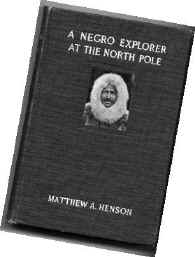 |
2
Matthew Henson: used and
frozen out, calumny and
falsehood on the Internet
"...certain
(Afro-American web) sites
are on the edge in terms
of legitimacy" says
Professor Lee D. Baker,
Columbia University,
Afro-American Studies
Black
History Month is in
February, and this year the
New York Times used
the occasion to explore the
proliferation of web sites
on the Internet with
concentration on
African-American studies
and history. The expansion
"opens and enlightens
a whole new discussion, not
just for African-Americans,
but for everyone,"
says black scholar F. Leon
Wilson.
Yet
with the site growth comes
caution "and some
important caveats regarding
the use of the Internet to
search for information on
black history," says
the Times in a
feature by Eric V. Copage
on February 16. More to the
point was a writer who said
that she avoided title
searches because of the
possibility of linking with
pornographic or racist web
sites, urging instead that
searchers go directly to
recognized university
research sites (i.e.,
Harvard, UCLA, Howard,
etc.) to "avoid the
crackpots."
The
caution was expressed in
more direct terms by Dr.
Lee D. Baker, an associate
professor of Anthropology
and African-American
Studies at Columbia
University, who warned of
certain sites that were
"on the edge in terms
of legitimacy," such
as those put on line by
amateur history buffs.
Baker also recommended
starting with academic
sites as a way of finding
reliable information.
What
all this has to do with
Matthew A. Henson and the
web site dedicated to
anything and everything
about him will soon become
apparent. It is a curious
story, which involves a
webmaster who tolerates no
criticism and is quick to
play the "race
card" whenever any
oblique criticism of Henson
is suggested through
negative commentary about
Robert E. Peary, his
employer for most of the
two decades that both spent
in the Arctic.
The
webmaster is Verne D.
Robinson, the son of the
author of the first attempt
at a Henson biography,
Bradley Robinson, whose Dark
Companion was published
in 1947. A reprint edition
of the book is available
through a web site (www.matthewhenson.com).
Prepare for a potpourri of
everything from books to
T-shirts to videos and
framed posters. By far, it
is the most expansive and
exhaustive website for a
Polar explorer on the Net.
It also may be the most
vitriolic.
The
sad aspect is that an
apparent irrational
aversion to any criticism
of Robert E. Peary and his
claims to Polar discovery
is transferred to a
racially-rooted assault on
Frederick Cook. Baker's
"edge in terms of
legitimacy" emerges in
any objective surfing of
the Henson site. The true
and honest exploits of an
explorer who was used by
his employer in the same
cavalier manner in which he
related to his Inuit (or
Polar Eskimos) is thus
diminished.
The
story of Peary's
relationship with Henson
and his Eskimo companions
was recently revived with
the new publication of
author Kenn Harper's book, Give
Me My Father's Body (Steerforth
Press, 1999) which received
favorable reviews. The
story of Minik, "the
New York Eskimo,"
recalled all of the worst
aspects of white
imperialism at the turn of
the century. Harper places
both explorers into a
perspective of the true
racism that existed in the
far North at that time:
"But
although Peary lived among
the Eskimos, he clearly did
not feel them to be his
equals. They and Matthew
Henson, his black servant
and dog driver whom he once
berated for not calling him
"Sir" often
enough, were in Peary's
estimation members of
inferior races."
This
critique is accepted by
virtually all biographers
of Peary and those writers
and scholars who have
concentrated on the
exploration of the Arctic,
including the 1908-09
period of the conflicting
claims of discovery of the
geographical North Pole. In
the 1960's, John Edward
Weems, the
"official"
biographer of the Peary
family, did not deal with
Peary's racism. Earlier
biographers Fitzhugh Green
(1929) and William Herbert
Hobbs (1935)
matter-of-factly
acknowledge Peary's message
at the Pole, in which he
said that he was
accompanied by five men,
"Matthew Henson,
colored and four
Eskimo."
The
issue is not that Matthew
Henson is an unimportant
personage in black history.
By far, he beats out Peary
and other American Polar
explorers with books in
print, posters, films,
plays, memorials, markers,
works-in-progress and other
benchmarks of historic
activity. The Home Page
lists more than 50 topics
and even has award
certificates for Henson
supporters.
The
issue is that the webmaster
has decided to use his
domain for a vicious,
unsubstantiated character
assault against another
explorer, Frederick A.
Cook, in a pathetic effort
to somehow deflect the fact
that Peary's Polar star has
been receding for over a
decade. Because the younger
Robinson has convinced
himself that Henson is the
"co-discoverer"
of the Pole, any attack on
Peary or any advocacy of
Cook is seen as an assault
on Henson.
The
calumny and falsehood which
he has initiated and
reproduced on the Internet
(with all its protections
against libelous activity)
provides a sad departure
from serious scholarship,
and the difference of
opinion that responsible
historians deal with in
assessing controversy and
history. A few citations
from the Henson web pages:
A
Disagreeable Citric One
can disagree without being
disagreeable, but Robinson
is both. Of Cook's
expedition: "The
little SOB Cook went on a
sleigh ride." Of his
return to Denmark: "he
accepted awards from the
King of Copenhagen
(sic!)." His
assessment of the
controversy: "Yes, it
was a great ugly wound that
Cook's lies createdCook
ruined Peary."
Truth
as a Casualty Caption
under a circa 1938 picture:
"After prison Cook
became an alcoholic."
No news clipping, no
unfriendly writer or
author, or any paper in the
Peary or Cook collections
give credence to this
falsehood. Caption under
Cook entering prison:
"Freddy the Fraud
etc." No reference to
the wealth produced from
Cook's wells after he was
convicted of
misrepresenting their
value, the Presidential
pardon, or the Justice
Department's role in the
pardon.
Abandonment
The
Coulter book and cemetery
re-interment celebrated the
Inuit kin of both explorers
with the
"Black-White-Eskimo"
theme, while skirting the
obvious: both abandoned
their sons without any
acknowledgment and without
any provision for their
well-being in the Arctic.
In effect, they emulated
each other as very possibly
the first American deadbeat
dads in the Arctic.
Inverting
Racism Peary
saw Henson as just "an
extension of the fingers of
my hand" and never
considered him equal to his
white associates, yet
Robinson twists the Peary
criticism from Cook
supporters and others as
those who "don't like
the fact that an
African-American made it
possible for Peary to reach
the Pole."
Burn
this book. The
Henson webmaster has a
solution for any book which
does not accept the Henson/Peary
school: "burn
it." Of Wally
Herbert's book The Noose
of Laurels, he says
"Wally and his dumb
theorieswhere do these
idiots come from?" Of
Robert Bryce and his Cook
& Peary, "This
ridiculous bookis the best
candidate for burning we
know of."
Peary
on Henson Peary
and Henson returned from
their last Arctic
expedition in September
1909. Peary lived until
February 1920. With the
exception of Peary sending
a message (later the
forward to Henson's book)
in circa 1910 paternalism
("a credit to your
race" etc.) at a black
dinner honoring Henson,
there is no evidence that
the "Discoverer"
would again meet with his
Arctic associate of three
decades until he sent for
him on his death bed. Peary,
however, wrote on October
10, 1910 that "Henson,
after my looking after him
for many yearsand after
permitting him to go with
me to the Polehas deceived
me."
Whose
equal? Peary
dismissed Henson form his
service as soon as they
reached New York in 1909.
For a decade there is no
record that he invited
Henson to his home or to
any gathering of explorers,
and it is known that he did
nothing to obtain Henson
the parking attendant's job
that was secured by a black
politician. Cook, on the
other hand, took Henson
into his home and had his
snow blindness treated by a
specialist. It is the sort
of kindness that racists
disapprove of.
Henson's
Real Story Perhaps
because the webmaster is so
consumed with everything
about Henson, he did not
recognize the damning
document that he posted on
the site: "Matt Henson
Tells the Real Story of
Peary's Trip" which
was published in the Boston
American on July 17,
1910. Peary's behavior
"at the Pole" and
after, his confiscation of
Henson's diary and film,
and failure to respond to
his telegrams is all
detailed. You can access it
on the Henson site:
www.matthewhenson.com/bostonamerican.
Matthew
A. Henson portrait
from
"The Noose of
Laurels"
(right) the
"co-discoverer"
became
"the first man
to reach the North
Pole"
in this 1980's comic
book revisionism
. |
|
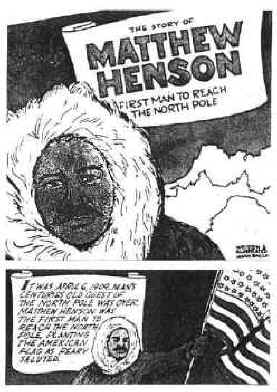 |
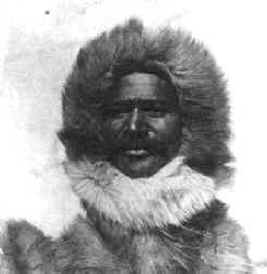 |
|
4
Henson tells real story of
Peary's trip to Pole
On the return trip, "Peary
scarcely spoke to me"
From
the 'Boston American,'
Sunday, July 17, 1910,
article by Matt Henson.
After
twenty-two long years of
service with Peary, we are
now as strangers. Three
times in his company I
crossed the "Great
Lead" north of Cape
Columbia on my way towards
the Pole, and three times
we recrossed together. The
last round trip was the
successful one. The North
Pole was reached. Three
hearty American cheers were
given for Old Glory as we
waved from an icy pinnacle.
It was the culmination of a
struggle lasting all those
years, in which Commander
Peary, the employer, and I,
plain Matt Henson, the
servant, had worked and
starved and frozen
together. From the moment I
declared to Commander Peary
that I believed we stood
upon the Pole, he
apparently ceased to be my
friend.
I
could never understand it
and cannot now. He was an
exact but very kind man in
authority. He was never
understandable.
On
the evening of the fifth
day after Captain Bartlett
willingly turned back with
his little division of
Eskimo dogs and sledges, we
encamped practically at the
Pole. I, who had walked,
knew that we had made
exceptional distances in
those five days. So did the
Eskimos, for they also had
walked. Lieutenant Peary
was the only surprised man.
He, because of his crippled
feet, had ridden on the
sledges the greater part of
the journey up, as he did
upon the return. Riding,
one cannot so well be judge
of distance traversed. He
made no observation in the
five days, merely knew we
had 132 miles to go, and he
supposed that we could
nearly make it in the five
days of marching.
ESKIMO
BOY DISCLOSES PEARY'S PLAN
When
we went into camp on the
evening of the fifth day,
actually the sixth day of
April, one of my Eskimo
boys I could talk their
language spoke sneeringly
to one of Commander Peary.
He said it was mean that
Peary had quietly planned
with him and one other
Eskimo boy to leave me in
camp the following morning
and go off to the Pole by
himself. It was mean, said
the young native, because
we were all so near, and I
had worked so hard to make
the trip a success.
It
stunned me at first,
because Commander Peary had
spoken nothing of it to me.
My first impulse was to
protest, but on second
thought I decided to wait.
In fact, I believed that
the full distance had
already been covered. One
can tell to within a mile
or so how far he walks in
that northern ice, and I
reckoned that we were even
now at the very Pole.
FOUND
THEMSELVES AT THE NORTH
POLE
True
enough, on the following
morning Commander Peary set
out with the two Eskimos
and one sledge with a tin
of pemmican and
instruments, leaving me
repairing a sledge and in
charge of the camp. I was
sorely disappointed, but
somehow I had an abiding
faith that he was wrong in
his calculations. In about
an hour the Commander
returned. His face was long
and serious. He would not
speak to me. I quietly
learned from the boys
accompanying him that he
had made observations a few
miles further on.
"Well,
Mr. Peary," I spoke
up, cheerfully enough,
"we are now at the
Pole, are we not?"
"I
do not suppose that we can
swear we are exactly at the
Pole" was his evasive
answer.
"Well,
I have kept track of the
distance and we have made
exceptional time," I
replied, "and I have a
feeling that we have just
about covered the 132 miles
since Captain Bartlett
turned back. If we have not
traveled in the right
direction then it is your
own fault."
Commander
Peary made no reply, but
going off by himself made
three separate
observations. I can make
observations myself, but of
course, I did not meddle at
this time. At the
conclusion of his tests he
ordered out the American
flag, selected a hillock of
ice and gave the word to
erect the Stars and Stripes
thereon. With the
assistance of the native
boys I did this. Then I led
a cheer for Old Glory. We
remained in the encampment
for about thirty-three
hours when word was given
for the return.
From
the time we knew we were at
the Pole, Commander Peary
scarcely spoke to me.
Probably he did not speak
to me four times on the
whole return journey to the
ship. I thought this over
and it grieved me much.
I
thought of the years we had
worked together for the
great aim. I remembered his
many acts of kindness and
naturally I did not forget
what I had done for him.
One never does that in
summing up to strike a
balance of friendship.
WAS
PEARY OFFENDED?
It
came over me that possibly
he had taken offence at us
on the journey up, because
so frequently we kept ahead
or just out of his reach so
that he might not load
himself upon our sledges.
He was very heavy for the
dogs to haul. We wanted him
to remain in his own
division. We knew he could
walk but little in rough
ice. Only one of his little
toes remained from that
terrible frosting of 1900.
He was compelled to ride.
But we did not court his
presence. Much of my work
was ahead of the main party
breaking the trail and
caring for advance things.
I
wondered if he remembered
with any gratitude those
awful days in 1900 when he
lost his toes and became a
cripple on my hands. Those
were days that even now
stand out from all the
rest. How I kept the men
and dogs in order,
traveling days and during
the night. How I foraged
with the dogs, like a dog
myself, hunting for food to
keep him alive and get him
back to civilization. We
hunted and captured any
living thing that was good
to eat, chase hares with
wolfish desperation, and I
finally saw him back to the
ship in the hands of the
surgeon, crippled for life
in a way, but safe and
eventually well.
It
nearly broke my heart on
the journey from the Pole
that he would arise in the
morning and slip away on
the homeward trail without
rapping on the ice for me,
as was the established
custom. As we approached
our goal, he vouchsafed a
few words in effect that he
hurry on ahead, losing one
night's sleep, while I
could bring the party in at
my leisure.
DID
NOT SAY GOOD-BY
On
board the ship he addressed
me a very few times. When
we left the ship he did not
speak. I wrote to him twice
and sent a telegram, but
received no reply from him.
I
had worked for Commander
Peary all those years for
the sum of $35 a month and
found, until this last
trip, when I received $50 a
month and keep, and I had
scarcely enough money to
support my family in the
States. In my letters I
hoped for some
understanding.
But
no reply came until I was
signed for a series of
lectures. When I had given
my first lecture I received
a telegram from Commander
Peary warning me not to use
the pictures. At once I sat
down and wrote him another
long letter. He never
replied to it. I have kept
my lectures and
illustrations.
And
bear in mind that all the
pictures were taken by me.
Besides those I am now
exhibiting, I exposed 110
films about the Pole which,
upon his request, I loaned
to Commander Peary. It was
my camera. I paid for the
films, exposed and
developed them. He borrowed
the films saying he would
use some and return them to
me. He has never done this,
and for all I know, has my
110 films in his
possession.
Matthew
Henson aboard Peary's ship,
the 'Roosevelt,' photo from
North Pole Legacy by S.
Allen Counter.
The
caption to this photo
reads: "The four
North Pole Eskimos, from
Henson's own
photograph." from his
book, A
Negro Explorer at the North
Pole, 1912.
In
the book, North
Pole Legacy: Black,
white, and Eskimo by S.
Allen Counter, 1991, the
caption to this photo
reads:
"The four Polar
Eskimos who accompanied
Henson and Peary to the
North Pole.
Left to right:
Egingwah, Ootah, Ooqueah,
and Seegloo. Peary
Collection, National
Archives."
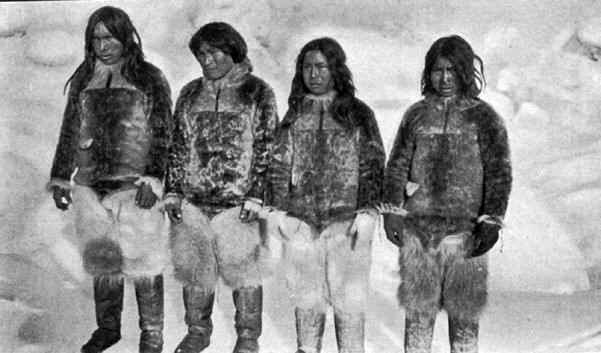
5
Matthew
Henson and Robert E. Peary:
Co-discoverers or
Co-conspirators? Matthew
Henson and Robert E. Peary:
Co-discoverers or
Co-conspirators?
Critics
see Henson as a tragic
figure and innocent dupe of
Peary's giant ego and
ambition, yet he was a
significant Arctic
traveler, without whom
Peary would never have
achieved any note.
by
Ted Heckathorn
During
the past few years, several
individuals have advanced
the novel theory that
AfricanAmerican Arctic
explorer, Matthew Henson,
was a codiscoverer of the
North Pole in April 1909.
In fact, a few of the more
fanatical Henson advocates
have gone so far as to
suggest that Henson
actually got to the North
Pole before Peary did.
Peary's critics have
portrayed Henson as a
tragic figure and an
innocent dupe of Peary's
giant ego and ambitions.
Curiously,
this recent promotion of
Henson's role as Peary's
essential-other has
occurred simultaneously
with stunning disclosures
from Peary's longsuppressed
personal papers that
document their failure to
reach the North Pole in
1909. Peary's own written
records also substantiate a
series of prior spurious
geographical claims. Since
Henson participated in all
of Peary's expeditions
between 1891 and 1909, his
degree of complicity in
these exploring hoaxes
merits serious examination
by polar historians.
A
study of the available
information indicates
Henson did not have a happy
childhood and ran away from
his step-mother's home at
an early age. He had no
formal schooling, and went
to sea as a ship's cabin
boy at age twelve. A kindly
captain served as Henson's
mentor during his formative
years, and provided the
only stable home and family
he had ever known. After
the captain's death, Henson
returned to the Washington,
D.C. area, where he worked
in menial jobs until he met
Peary.
Henson
went to the Arctic on
Peary's first North
Greenland Expedition in
189192, as Peary's servant.
No doubt his experience as
a seaman was useful, but he
did not play a significant
role in the expedition in
either the scientific or
geographic accomplishments.
He did gain experience in
Arctic travel and became
acquainted with the Inuit
of Smith Sound. On the
other hand, his frequent
quarrels with one of the
scientists, Verhoeff, had a
detrimental effect on the
morale at the base camp,
and may have been a factor
in Verhoeff's mysterious
disappearance shortly
before the expedition's
return to the United
States.
The
main accomplishments of the
expedition were the icecap
journey of Peary and the
Norwegian, Eivind Astrup,
the ethnology work by Dr.
Frederick Cook, bird
studies by Langdon Gibson,
Verhoeff's weather
observations, and Mrs.
Peary's being a female
member of the party. Peary
claimed to have discovered
the Peary Channel that
split Greenland. This was
the first of Peary's major
geographic hoaxes, but it
was not publicly exposed
until two decades later.
In
1893, Henson again returned
to Greenland with Peary and
Astrup. Cook had withdrawn
from the expedition when
Peary refused him the right
to publish the scientific
results of the 189192
expedition. Mrs. Peary gave
birth to a daughter. Bad
weather and misfortune
prevented any serious
exploration. At the end of
the first year, Peary
lacked enough food to
supply the expedition for
another year, so he sent
his wife and everyone home
except for Henson and Hugh
Lee. Not long thereafter,
he fell in love with a
14year-old Inuit girl. The
three men spent the winter
with their Inuit friends
and planned a new journey.
In
the spring of 1895, they
were shocked when they
could not find the supplies
they had cached on the
icecap the previous year.
Without such supplies and
equipment there was little
chance of making new
geographical discoveries in
the interior of Greenland.
Although such a journey
bordered on insanity, Peary
was in a bind. If he
returned without making any
new discoveries, his
expedition would be branded
a failure, and eventually
someone would expose his
Peary Channel hoax. His
only hope was to make some
astounding new find that
would enable him to disavow
his Peary Channel scam as
an "honest"
mistake. Henson and Lee did
not have as much experience
on the ice, and obviously
did not realize what a
great gamble Peary was
taking with their lives.
By
the time they reached the
vicinity of Peary's
accursed channel, all three
were starving, and Lee
could go no further.
Luckily Henson and Peary
located and killed a few
musk oxen. With this meat
and by eating their dogs,
they barely made it back to
their base on Smith Sound,
but were too weak to hunt.
Peary admitted they would
have starved to death in
their own comfortable
building near plentiful
hunting grounds, if the
Inuit had not come to their
rescue. Later Peary would
attack a prior explorer,
General Greely, because
many of that party died of
starvation in a makeshift
stone hut on the bleak
shores of Cape Sabine,
Ellesmere Island. Peary was
more fortunate that his
outside help arrived in
time.
Henson
and Lee obviously would
have seen that the Peary
Channel did not exist, but
like Astrup, chose to keep
the information from the
public. Astrup, however,
had privately shared the
secret with Dr. Cook. One
other nasty little secret
that the public (and Mrs.
Peary) did not know was
that Peary, Lee and no
doubt Henson had taken
Inuit mistresses in the
Arctic.
Peary
and Henson rewarded the
Greenlanders for all of
their generosity in a
rather peculiar fashion.
They opened graves, both
old an new, and took the
bodies and effects of the
deceased men, women and
children to be used as
exhibits in American
museums. Peary also took
several living specimens to
New York for scientific
study. When the unfortunate
visitors died of disease,
they too were cleaned and
mounted as exhibits in the
American Museum of Natural
History (AMNH). One little
boy, Mene (Minik) Wallace
who survived, thought that
his father had been buried.
It later turned out that
the funeral was a sham, and
the skeleton of this man
who had served Peary so
loyally, was put on display
to entertain the public.
Neither Peary nor Henson
uttered a word of protest
to this outrage, and in
fact Henson happily took a
job with the museum, and
Peary continued to receive
generous contributions from
the AMNH.
Besides
this disgusting trade in
human bodies, Peary
directly and Henson
indirectly benefited in a
scheme to import furs and
ivory without paying the
required import duty. Peary
shipped the
"scientific
specimens" merchandise
directly to the AMNH to
evade the tax. The museum
then rebated part of the
merchandise back to Peary
to sell to other museums
around the country. Again,
neither Peary nor Henson
expressed any civic remorse
about evading the federal
taxes that other citizens
were required to pay.
Another
bit of scientific thievery
occurred in 1895 and 1897,
when Peary with Henson's
able assistance took three
meteorites from North
Greenland. For generations
these heavenly gifts were
the only source of iron for
the Greenlanders who had
carefully concealed their
whereabouts from outsiders.
Unsuccessful at first,
Peary eventually found a
native that succumbed to
bribery and revealed the
location. Within two years
Peary had absconded with
all three meteorites and
sold them for a large sum;
the Greenland community was
never compensated for their
loss. Now they were totally
dependent on outsiders for
iron for their harpoons,
arrows, knives and other
essential items for their
basic needs. Henson
complained about the hard
work of moving the largest
meteorite, but not a word
about robbing his beloved
"Inuit brothers"
of this valuable asset.
On
the following PearyHenson
trip to Greenland in 1898,
another explorer, Otto
Sverdrup, appeared on the
scene. Sverdrup planned to
circumnavigate Greenland
rather than seek the North
Pole. For Peary, that
created an even greater
danger. If Sverdrup
succeeded, he would
undoubtedly discover the
Peary Channel hoax, and
Peary's exploring career
would end in disgrace. In a
rash attempt to disrupt
Sverdrup, Peary risked an
insane journey north to
prevent the Norwegians from
using Greely's old base at
Fort Conger. Greely's large
building could easily have
accommodated both
expeditions, but such
international polar
cooperation in the field
was not an option that
Peary would consider.
In
December 1898, Peary,
Henson, Dr. Thomas Dedrick
and four Greenlanders set
off for Fort Conger, a trip
that resembled the mad
journey of 1895. By the
time they reached their
destination, Peary had
frozen both of his feet.
Peary lost most of his
toes, but the diligent
medical care by Dr. Dedrick
saved his feet. Years
later, Henson biographer,
Bradley Robinson, totally
expunged Dedrick from the
trip to Fort Conger and
claimed that it was
Henson's medical care that
saved Peary's feet. Henson,
who furnished information
for the biography, never
renounced this bit of
dishonesty or any of the
other false statements,
distortions or outright
fabrications that appeared
in the book.
For
example, in the biography
on page 196, Robinson
alleged a fictitious
dialogue between
Koodlooktoo and Henson at
the Big Lead in March 1909.
Koodlooktoo was not even
there at the time. He was
back at Cape Columbia and
attempting to desert the
expedition. Only vigorous
efforts by Professor Ross
Marvin foiled this AWOL
attempt by Peary and
Henson's prize Inuit protégé.
Since nearly all of the
other principals were dead
when this book was written,
Henson was clearly
responsible for correcting
this and other false
statements in the book. One
also would expect
biographer Robinson to make
at least a token effort to
read Henson's prior
autobiography and Peary's
account of the various
expeditions, and check a
few of the known facts.
Many of the other quoted
conversations in Robinson's
book are doubtful and,
where they can be
cross-checked, they are
usually refuted.
Peary's
effort succeeded in turning
Sverdrup away from
Greenland. The Norwegians
relocated to Jones Sound
and proceeded to discover
thousands of miles of new
land, as well as many
islands and waterways of
present day Nunavut. On the
other hand, Peary, Dedrick
and Henson were rewarded
with the discovery of only
a few miles of Northern
Greenland to show for their
four year expedition. Peary
did become the father of a
son by his Greenland
mistress, but there was not
much else of a positive
nature. During the summer
of 1900 at Fort Conger, the
three demolished Greely's
building, as Henson and
Dedrick struggled for the
affection of an Inuit
woman. Dedrick won but
later regretted his
victory. Peary, and
probably Dedrick and
Henson, developed scurvy
from eating the 18-yearold
canned food left by the
Greely expedition, and as a
result were unable to do
field work in 1901. During
this period Henson became
insubordinate with both
Peary and Dedrick, who was
second in command, and
Peary had to take action.
This may have been a side
effect of the scurvy.
During
the summer of 1901, they
returned south to meet the
expedition ships. By the
time they arrived, Dedrick
and Peary were angry with
each other, and Peary fired
Dedrick. Despite the loss
of his toes, Peary was
adamant about remaining in
the Arctic until he had
achieved something of
significance. Dedrick also
insisted on remaining
without pay because of his
professional obligation to
provide medical care. Peary
refused to allow Dedrick to
stay at his Cape Sabine
base or allow Dedrick to
treat the sick Inuit at the
base. As a result, a number
of Peary's most loyal Inuit
died during the fall of
1901. Again Henson's
biographer Robinson,
preferred to avoid
discussing this cruel and
unnecessary treatment of
those generous people who
had shared their homes,
food and wives while
risking their lives to help
the explorers. In the
spring of 1902, Peary and
Henson achieved a local
"Farthest North''
record on the Arctic Ocean,
but it was far short of the
world record set by
Norwegian and Italian
expeditions and the loss of
the Inuit lives was glossed
over.
Peary
and Henson returned to the
Arctic in 1905, with high
hopes for discovering the
Pole. Peary's new ship, the
Roosevelt, succeeded
in reaching the Arctic
Ocean, with a large
contingent of Inuit men,
women and children. The
muskoxen herds of northern
Ellesmere Island were
decimated to near
extinction to feed so many
people. Peary's 1906
journey on the ice quickly
ran into trouble. Henson,
who was leading the advance
party veered far off course
to the west, but pace was
too slow to have any hope
of success. Storms and open
leads also delayed them,
and their dogs were
starving from lack of food.
After
separating from the rest of
the literate expedition
members, Peary reported
that he and Henson had made
incredible speed to set a
new world's record beyond
87 degrees. British
explorer, Wally Herbert, in
recent years examined
Peary's personal records
and found that the claim
belied known facts of human
endurance. In order to have
reached such a latitude,
Peary and Henson would have
had to travel 86 miles on
the ocean ice in one day
"without
resting," all of this
without detours and with
starving dogs providing the
transportation.
In
an attempt to salvage
something from the
expedition, Peary made a
subsequent journey West to
try to discover some new
land. Henson was left at
the ship, and Peary took
only Inuit with him. After
the expedition arrived back
in the United States, Peary
announced that he had made
a major new discovery,
Crocker Land, named in
honor of San Francisco
banker, George Crocker.
This land does not exist,
and we now know from
Peary's own diary and
letters that it was a fund
raising hoax. Although
Henson was not with Peary
at the time, he later must
have learned from
conversations with his
Greenland friends that
there was no such land. As
with the Peary Channel
affair, Henson remained
silent while this
geographical hoax was
perpetrated on the
scientific world, and
erroneous maps printed.
On
Peary's final expedition in
190809, Henson again led an
advance party on the ice.
Again they quickly ran into
trouble when the long,
heavy sledges that he built
broke apart on the rough
ice. An even more serious
problem emerged when leaks
occurred in the fuel cans
that Henson made. Professor
Ross Marvin, the expedition
navigator and a veteran of
the 190506 expedition, made
an emergency trip back to
land to get more fuel.
After much difficulty he
found his way back to
Peary's party. Peary had
been dissatisfied with
Bartlett and Henson's
progress in the advance
party so he assigned Marvin
to lead and increase the
daily distance. Peary's
diary is critical of Henson
and suggests a lack of
initiative. This does seems
unfair since Henson was
breaking trail and doing
hard work while Peary was
riding on a sledge much of
the time.
A
short time later, Peary
sent Marvin back to land
with Koodlooktoo and a
hottempered Greenlander
nicknamed "Harrigan."
This eliminated the best
navigator in the party, and
a few days later, Captain
Bartlett was also sent
back. Peary now was the
only navigator left and the
only one who could
determine where they were
on the Arctic Ocean.
As
in 1906, suddenly the daily
distances jumped sharply
once the other literate
witnesses were gone. When
Henson thought they had
gone far enough to reach
the Pole, Peary brushed off
his congratulations. In
fact, after Peary made his
solar observations, he
became very cold with
Henson, declined to shake
hands with him and from
that time, rarely spoke to
him. Even more puzzling,
Peary later confiscated the
110 photographs that Henson
took at their
farthest-north camp. They
have never been located
since that time. Between
1989 and 1993, this writer
made a diligent search of
the Peary records in the
National Archives, the
National Geographic Society
and many other
organizations to locate the
Henson photographs. Neither
those nor Henson's alleged
diary could be located.
After
Henson and Peary returned
to the ship, Henson made
contradictory statements to
Dr. John Goodsell about the
appearance of the sun at
the Pole. Also after their
return they learned that
Marvin had died during his
return journey. Goodsell
had questioned Koodlooktoo
about the death, but the
Inuit suddenly departed on
a trip to the north coast
of Greenland with Donald
MacMillan and George Borup.
During their journey,
Koodlooktoo wrote a
confession in the snow that
he killed Marvin. MacMillan
and Borup both saw the
writing but did not realize
what it was. Marvin's other
companion was aboard ship,
but there is no record that
Henson, who had the best
knowledge of the native
language, ever made any
serious effort to question
the two companions.
When
the expedition returned to
the Greenland settlements,
they learned that Dr. Cook
had arrived there a few
months previously, and
reported that he had
reached the North Pole in
1908. Henson now showed
more interest in
questioning the Inuit, and
at Peary's behest,
interrogated Cook's two
companions. From Borup's
transcription we now know
that both Peary and Henson
made false statements about
what the two Inuit said. In
this case Peary personally
denied Dr. Goodsell
permission to question
these two Inuit. Although
Goodsell was not as fluent
in the language as Henson,
he was better qualified
than MacMillan and Borup
who were with Henson at the
interrogation (Borup was
the scribe).
After
returning to the United
States, Peary became very
hostile towards Henson. His
correspondence with the
president of the Peary
Arctic Club clearly
reflects his fears about
what Henson might tell
reporters. In one newspaper
interview, Henson provided
information that seriously
damaged Peary's North Pole
claim, but it was generally
ignored at that time. Peary
reaped significant money
and honors for attaining
the North Pole, while
Henson was mostly ignored.
When Congress investigated
Peary's North Pole claim,
it is significant that
Henson was never called as
a witness.
Some
historians have suggested
that race was a factor.
None of Peary's own
personal papers ever
suggested that he wanted
Henson to testify, or that
his North Pole claim would
be damaged because he could
not use Henson as a
witness. A few years later,
when MacMillan offered to
bring Cook's two companions
to the United States to
testify about Cook's claim,
Peary strenuously objected
on the basis of "who
knows what they might
say." Apparently Peary
felt the same way about
Henson.
In
retrospect, Matthew Henson
was a significant American
Arctic explorer. Without
Henson's assistance there
is no doubt that Robert
Peary would have achieved
far less than he did, and
Peary probably would have
died on the ill conceived
1895 icecap trip. Henson
certainly had great
physical courage and he
served Peary faithfully for
nearly two decades for
little more than room and
board.
On
the other hand, Henson
repeatedly showed a lack
moral courage and honesty
in regards to Peary's major
geographical hoaxes such as
the Peary Channel and the
1906 "Farthest
North" claims. Other
than a minor complaint
about Peary cheating the
Greenlanders on the
purchase of sled dogs in
1908, he remained silent
about years of Peary's
exploitation of the Inuit.
These actions included
robbing their graves and
their invaluable meteorites
(where he was an active
participant), not making an
objection when they were
denied available medical
attention in 1901, and
abandoning his own half
Inuit son in Greenland. For
many years both Bartlett
and MacMillan made annual
voyages to North Greenland,
and he could have at least
sent some message or small
gifts to his only child.
French explorer Jean
Malaurie described the
anguish of his son in
The Last Kings of Thule.
Henson
personally and knowingly
made false statements about
Dr. Frederick Cook and
General Greely to damage
their reputations. These
included the 1909
interrogation of Cook's
companions and details
about the conditions at
Fort Conger in 1899,
because the Inuit had been
there after Greely departed
in 1883. Additionally he
did not disavow Robinson's
biography, Dark
Companion (1947). He
either knew or should have
known was filled with false
statements and blatant
fabrications. Even if
illiterate, as historians
such as Weems and Rawlins
have suggested, it is
inconceivable that no one
read the book to him, or
told him what it contained.
REFERENCES
Bartlett,
Bob. Diary, 1909
Peary Arctic
Expedition.
Library of the American
Geographical Society, NY.
Borup, George. A
Tenderfoot With Peary.
1912, NY: Frederick A.
Sokes Co.
Cook, Frederick A. My
Attainment of the Pole.
1913, Mitchell Kennerley
& Co.
Hall, Thomas F. Has the
North Pole Been Discovered?
Boston: R.G. Badger
Co.
Harper, Kenn. Give Me
My Father's Body.
1999, VT: Steeforth Press.
Hayes, J. Gordon. Robert
Edwin Peary. 1929,
London: Grant Richards.
Heckathorn, Ted. In Cook
Reconsidered, Symposium
Proceedings No. 18, Byrd
Polar Research Center,
1993, Columbus, OH: Ohio
State Univ.
Henson, Matthew. A
Negro Explorer at the Pole.
1912, NY: Frederick A.
Stokes Co.
Herbert, Wally. Noose
of Laurels. 1989, NY:
Atheneum Publishing Co.
Goodsell, John. On
Polar Trails. 1993,
Austin, TX: University of
Texas Press.
Malaurie, Jean. The
Last Kings of Thule.
1955, NY: E.P. Dutton Co.
Peary, Robert. Northwards
Over the Great Ice.
1898, NY: Frederick A.
Stokes Co. (See also Peary
Papers, National Archives.)
Rawlins, Dennis. Peary
at the North Pole:
Fact or Fiction? 1973,
NY: Luce.
Robinson, Bradley. Dark
Companion. 1947, NY:
McBride Co.
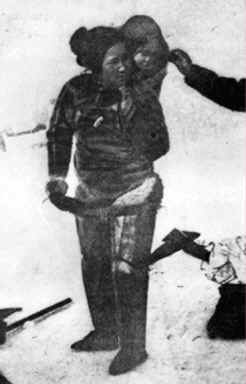 |
.... |
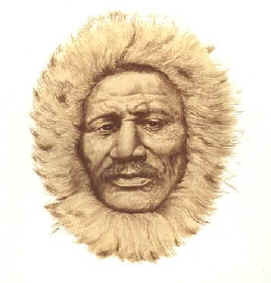
|
Ahikasingwah
and her baby, Kali, the
younger of Robert Peary's
two sons, from My
Attainment of the Pole by
Frederick Cook, 1913.
The
designation as "the
first man to reach the
North Pole" was
accorded henson in this
series of minibusts
distributed as the
"Seagram Gallery of
Famous Negro
Americans," c. 1970.
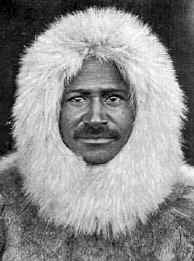 |
"Henson
immediately after the
sledge journey to the
pole and back."
Photo from A
Negro Explorer at the
North Pole.
Peary
"riding the
homeward trail,"
photo from The
Noose of Laurels
by Wally Herbert. |
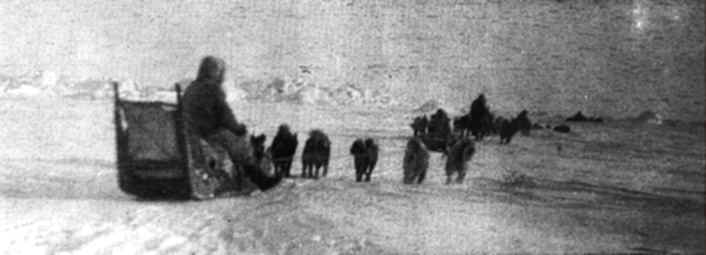
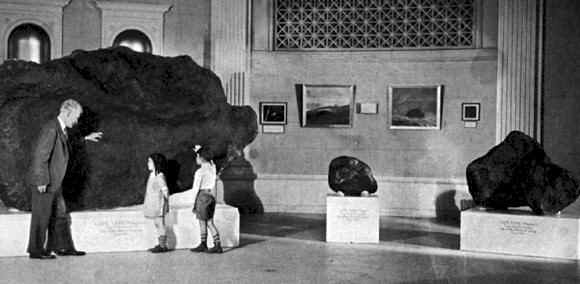
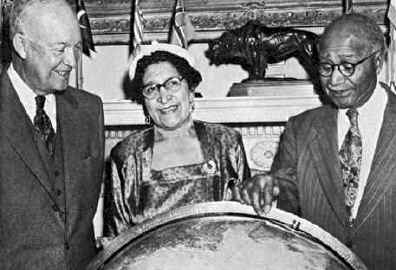 |
... |
The
three meteorites
delivered by Peary --
some say stolen -- to
the American Museum of
Natural History.
President Dwight
Eisenhower receives
88-year-old Matthew
Henson and his wife
Lucy on April 6, 1954,
the 45th anniversary
of Peary's alleged
arrival at the North
Pole. Photos
from To
the Top of the World:
The Story of Peary and
Henson by Pauline
K. Angell, 1964. |
Copyright
2005 - The Frederick A.
Cook Society
|